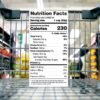Strategies to Minimize Sugar in Clean Eating
Introduction
In the pursuit of a healthier lifestyle, clean eating has emerged as a popular approach, emphasizing whole foods and minimal processing. However, hidden sugars can often sabotage our efforts to eat clean. Consuming excessive sugar is linked to various health issues, including obesity, diabetes, and heart disease. Therefore, minimizing sugar intake is crucial for those committed to clean eating. This article explores effective strategies to reduce sugar consumption while maintaining a clean diet.
Understanding Sugar in Clean Eating
Before diving into strategies, it’s essential to understand the role sugar plays in clean eating. Naturally occurring sugars, found in fruits and vegetables, are generally acceptable within a clean diet. The concern lies with added sugars, which are introduced during processing or preparation. These sugars enhance flavor but contribute empty calories and can lead to health complications. Clean eating focuses on consuming nutrient-dense foods, making it imperative to distinguish between natural and added sugars.
Read Labels Carefully
One of the most effective strategies to minimize sugar intake is to become a vigilant label reader. Food manufacturers often add sugar to enhance flavor, even in products that aren’t traditionally sweet. By carefully examining ingredient lists and nutritional labels, you can identify added sugars. Look for terms like sucrose, high-fructose corn syrup, barley malt, and dextrose. Aim to choose products with minimal or no added sugars.
Limit Processed Foods
Processed foods are notorious for containing hidden sugars. The convenience of these items often comes at the cost of added sweeteners. By limiting processed foods and opting for whole, unprocessed alternatives, you can significantly reduce sugar intake. Whole foods, such as fruits, vegetables, whole grains, lean proteins, and healthy fats, form the foundation of a clean eating plan. Preparing meals from scratch ensures you have control over the ingredients, minimizing the risk of consuming added sugars.
Choose Natural Sweeteners Wisely
While reducing sugar is the goal, completely eliminating sweetness isn’t necessary. Natural sweeteners can be a part of a clean eating plan when used judiciously. Options like honey, maple syrup, and coconut sugar are less processed and contain beneficial nutrients. However, they should still be used in moderation. Stevia and monk fruit are zero-calorie sweeteners derived from plants that can provide sweetness without impacting blood sugar levels. Incorporating these alternatives can satisfy sweet cravings without compromising clean eating principles.
Focus on Whole Fruits
Whole fruits are an excellent way to satisfy a sweet tooth naturally. Unlike fruit juices or dried fruits, whole fruits contain fiber, which slows down sugar absorption and provides a feeling of fullness. Berries, apples, and citrus fruits are particularly beneficial due to their high fiber and low glycemic index. Including a variety of colorful fruits in your meals not only curbs sugar cravings but also provides essential vitamins and antioxidants.
Experiment with Spices
Spices are a powerful tool in minimizing sugar intake while enhancing the flavor of meals. Cinnamon, nutmeg, and vanilla are excellent choices for adding sweetness without sugar. These spices can be incorporated into both sweet and savory dishes, providing depth and complexity to flavors. Additionally, certain spices like cinnamon have been shown to help regulate blood sugar levels, making them a valuable addition to a clean eating plan.
Opt for Unsweetened Products
In the realm of dairy and plant-based alternatives, unsweetened versions should be your go-to choice. Many flavored yogurts, almond milk, and other dairy substitutes are loaded with added sugars. By selecting unsweetened varieties, you maintain control over the sweetness of your meals. If needed, you can add a small amount of natural sweetener or fruit to achieve the desired level of sweetness.
Stay Hydrated with Water
Beverages are a significant source of hidden sugars, often overlooked in a clean eating plan. Sugary drinks, including sodas, energy drinks, and even some fruit juices, can quickly elevate sugar intake. To minimize sugar consumption, prioritize water as your primary beverage. Herbal teas and infused water with slices of fruit or herbs are excellent alternatives that add flavor without added sugars. Staying hydrated with water also supports overall health and can help reduce sugar cravings.
Plan and Prepare Meals
Meal planning and preparation play a crucial role in minimizing sugar intake. By planning meals and snacks ahead of time, you can ensure that you have wholesome options readily available, reducing the temptation to reach for sugary convenience foods. Batch cooking and prepping ingredients in advance can save time and make it easier to adhere to a clean eating plan. Additionally, having healthy snacks on hand, such as nuts, seeds, and fresh fruits, can prevent impulse purchases of sugary treats.
Educate Yourself on Sugar Substitutes
Understanding the difference between various sugar substitutes is essential for making informed choices. While artificial sweeteners like aspartame and sucralose are low in calories, their long-term health effects are still debated. Opt for natural alternatives like stevia and monk fruit, which have been used traditionally and are generally considered safe. Educating yourself on these options allows you to make choices that align with your clean eating goals while satisfying your sweet tooth.
Practice Mindful Eating
Mindful eating is a powerful practice that encourages awareness and intentionality in food choices. By savoring each bite and paying attention to hunger and fullness cues, you can develop a healthier relationship with food. This practice helps reduce emotional eating and the tendency to reach for sugary snacks out of habit. Taking time to appreciate the flavors and textures of whole foods can lead to greater satisfaction and reduce the desire for added sugars.
Address Emotional Triggers
Emotional eating often involves turning to sugary foods for comfort or stress relief. Identifying and addressing emotional triggers is crucial for reducing sugar intake. Engaging in alternative stress-relief activities, such as exercise, meditation, or journaling, can provide healthier outlets for emotions. Building a support system and seeking professional guidance, if necessary, can also aid in overcoming emotional eating patterns.
Conclusion
Minimizing sugar in clean eating is a vital step towards achieving and maintaining a healthy lifestyle. By understanding the sources of hidden sugars and implementing the strategies outlined in this article, you can reduce sugar intake while still enjoying a wide variety of delicious and nutritious foods. Emphasizing whole foods, reading labels, and practicing mindful eating are key components of a successful clean eating plan. As you embark on this journey, remember that gradual changes and consistency are more sustainable than drastic restrictions.















Add comment